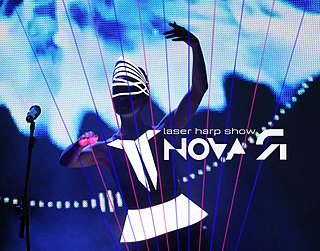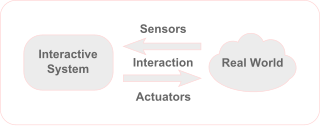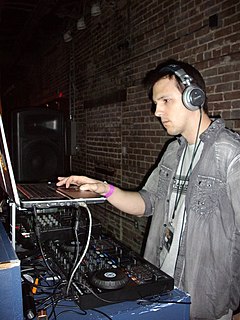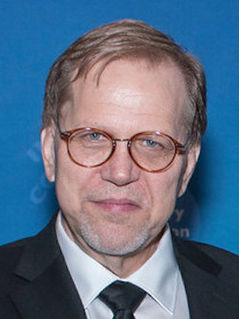Related Research Articles

MIDI is a technical standard that describes a communications protocol, digital interface, and electrical connectors that connect a wide variety of electronic musical instruments, computers, and related audio devices for playing, editing, and recording music. The specification originates in a paper titled Universal Synthesizer Interface, published by Dave Smith and Chet Wood, then of Sequential Circuits, at the October 1981 Audio Engineering Society conference in New York City.
In the seven-layer OSI model of computer networking, the physical layer or layer 1 is the first and lowest layer; The layer most closely associated with the physical connection between devices. This layer may be implemented by a PHY chip.

An electronic keyboard, portable keyboard, or digital keyboard is an electronic musical instrument, an electronic or digital derivative of keyboard instruments. Broadly speaking, the term electronic keyboard or just a keyboard can refer to any type of digital or electronic keyboard instrument. These include synthesizers, digital pianos, stage pianos, electronic organs and digital audio workstations. However, an electronic keyboard is more specifically a synthesizer with a built-in low-wattage power amplifier and small loudspeakers.

A MIDI controller is any hardware or software that generates and transmits Musical Instrument Digital Interface (MIDI) data to MIDI-enabled devices, typically to trigger sounds and control parameters of an electronic music performance. They most often use a musical keyboard to send data about the pitch of notes to play, although a MIDI controller may trigger lighting and other effects. A wind controller has a sensor that converts breath pressure to volume information and lip pressure to control pitch. Controllers for percussion and stringed instruments exist, as well as specialized and experimental devices. Some MIDI controllers are used in association with specific digital audio workstation software. The original MIDI specification has been extended to include a greater range of control features.

Gesture recognition is a topic in computer science and language technology with the goal of interpreting human gestures via mathematical algorithms. It is a subdiscipline of computer vision. Gestures can originate from any bodily motion or state but commonly originate from the face or hand. Current focuses in the field include emotion recognition from face and hand gesture recognition. Users can use simple gestures to control or interact with devices without physically touching them. Many approaches have been made using cameras and computer vision algorithms to interpret sign language. However, the identification and recognition of posture, gait, proxemics, and human behaviors is also the subject of gesture recognition techniques. Gesture recognition can be seen as a way for computers to begin to understand human body language, thus building a richer bridge between machines and humans than primitive text user interfaces or even GUIs, which still limit the majority of input to keyboard and mouse and interact naturally without any mechanical devices.

A sound module is an electronic musical instrument without a human-playable interface such as a piano-style musical keyboard. Sound modules have to be operated using an externally connected device, which is often a MIDI controller, of which the most common type is the musical keyboard. Another common way of controlling a sound module is through a sequencer, which is computer hardware or software designed to record and playback control information for sound-generating hardware. Connections between sound modules, controllers, and sequencers are generally made with MIDI, which is a standardized interface designed for this purpose.

A tangible user interface (TUI) is a user interface in which a person interacts with digital information through the physical environment. The initial name was Graspable User Interface, which is no longer used. The purpose of TUI development is to empower collaboration, learning, and design by giving physical forms to digital information, thus taking advantage of the human ability to grasp and manipulate physical objects and materials.

New Interfaces for Musical Expression, also known as NIME, is an international conference dedicated to scientific research on the development of new technologies and their role in musical expression and artistic performance.

A laser harp is an electronic musical user interface and laser lighting display. It projects several laser beams played by the musician by blocking them to produce sounds, visually reminiscent of a harp. It was popularised by Jean-Michel Jarre, and has been a high-profile feature of almost all his concerts since 1981. The laser harp became famous in Asia by Japanese artist Susumu Hirasawa.

Physical computing involves interactive systems that can sense and respond to the world around them. While this definition is broad enough to encompass systems such as smart automotive traffic control systems or factory automation processes, it is not commonly used to describe them. In a broader sense, physical computing is a creative framework for understanding human beings' relationship to the digital world. In practical use, the term most often describes handmade art, design or DIY hobby projects that use sensors and microcontrollers to translate analog input to a software system, and/or control electro-mechanical devices such as motors, servos, lighting or other hardware.
STEIM was a center for research and development of new musical instruments in the electronic performing arts, located in Amsterdam, Netherlands. Beginning in the 1970's, STEIM became known as a pioneering center for electronic music, where the specific context of electronic music was always strongly related to the physical and direct actions of a musician. In this tradition, STEIM supported artists in residence such as composers and performers, but also multimedia and video artists, helping them to develop setups which allowed for bespoke improvisation and performance with individually designed technology.

A wind controller, sometimes referred to as a wind synthesizer, is an electronic wind instrument and usually in the form of a MIDI controller associated with one or more music synthesizers. Wind controllers are most commonly played and fingered like a woodwind instrument, usually the saxophone, with the next most common being brass fingering, particularly the trumpet. Models have been produced that play and finger like other acoustic instruments such as the recorder or the tin whistle. The most common form of wind controller uses electronic sensors to convert fingering, breath pressure, bite pressure, finger pressure, and other gesture or action information into control signals that affect musical sounds. The control signals or MIDI messages generated by the wind controller are used to control internal or external devices such as analog synthesizers or MIDI-compatible synthesizers, synth modules, softsynths, sequencers, or even non-instruments such as lighting systems.

A projection keyboard is a form of computer input device whereby the image of a virtual keyboard is projected onto a surface: when a user touches the surface covered by an image of a key, the device records the corresponding keystroke. Some connect to Bluetooth devices, including many of the latest smartphone, tablet, and mini-PC devices with Android, iOS or Windows operating system.

Disklavier is the brand name for a family of high-tech reproducing pianos made by Yamaha Corporation. The first Disklavier was introduced in the United States in 1987.
IEEE 1451 is a set of smart transducer interface standards developed by the Institute of Electrical and Electronics Engineers (IEEE) Instrumentation and Measurement Society's Sensor Technology Technical Committee describing a set of open, common, network-independent communication interfaces for connecting transducers to microprocessors, instrumentation systems, and control/field networks. One of the key elements of these standards is the definition of Transducer electronic data sheets (TEDS) for each transducer. The TEDS is a memory device attached to the transducer, which stores transducer identification, calibration, correction data, and manufacturer-related information. The goal of the IEEE 1451 family of standards is to allow the access of transducer data through a common set of interfaces whether the transducers are connected to systems or networks via a wired or wireless means.

Controllerism is the art and practice of using musical software controllers, e.g. MIDI, Open Sound Control (OSC), joystick, etc., to build upon, mix, scratch, remix, effect, modify, or otherwise create music, usually by a Digital DJ or Live PA performer, often called a controllerist. Controllerism is also a nod to traditional musicianship and instrumental-ism paired with modern computer sequencing software such as Ableton Live and Native Instruments Traktor. However a working knowledge of scales and chords is not necessarily required as the performers typically focus their efforts more on sequencing events, software effect and instrument manipulations using buttons, knobs, faders, keys, foot switches and pedals than on instrumental notes played in real time. With recent developments in music technology, particularly in software instruments, a USB MIDI controller enables musicians almost unlimited possibilities to control a wide variety of sound types.
The Miburi is a wearable musical instrument which was released commercially by the Yamaha Corporation’s Tokyo-based experimental division in 1994.

Keith McMillen is an audio and music technology engineer and entrepreneur, known for developing electronic music instruments, including the first modern violin to control synthesizers, first programmable audio mixer, the first bluetooth violin bow, and several MIDI controllers as well as innovations to improve audio quality for internet telephony.

The AudioCubes are a collection of wireless intelligent light emitting objects, capable of detecting each other's location and orientation, and user gestures, and were created by Bert Schiettecatte. They are an electronic musical instrument used by electronic musicians for live performance, sound design, music composition, and creating interactive applications in max/msp, pd and C++. The AudioCubes are an example of a Tangible User Interface as well as an ambient device.
References
- ↑ "Transcriptive Interaction". Archived from the original on 2011-06-06. Retrieved 2007-11-01.
- ↑ Advanced Topics in Digital Arts and Experimental Media
- ↑ Emerging Technologies and research purposes in new media
- ↑ Multimodal Interfaces and Physical Computing [ permanent dead link ]
- ↑ "Interactive Media Design". Archived from the original on 2007-08-08. Retrieved 2007-11-08.
- ↑ Medialogy
- ↑ Visual Performance and Installation Technologies
- ↑ The I-Cube System: moving towards sensor technology for artists